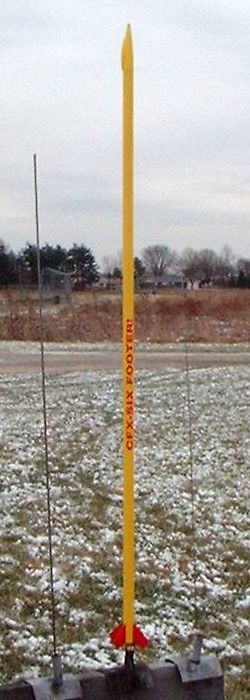Sunward Aerospace CFX-Six Footer!
Sunward Aerospace - CFX-Six Footer! {Kit}
Contributed by Chan Stevens
| Construction Rating: | starstarstarstarstar_border |
| Flight Rating: | starstarstarstarstar_border |
| Overall Rating: | starstarstarstarstar_border |
| Manufacturer: | Sunward Aerospace  |

Brief:
A "lite" Mean Machine, towering at about 6-1/2 feet tall, this
longneck is likely to be one of the tallest rockets at any launch. It's a
fairly simple build and flies fine on a single D12-5.
Construction:
I was cleaning up a few loose ends and decided to pull my prize from EMRR's
Longneck contest out of my build pile. I'm glad I did as this is a pretty nice
kit. The parts are good quality and include:
- 4 BT-56 x 18" body tubes
- 3 tube couplers
- Plastic nose cone (standard Sunward cone with canopy molded in)
- 4 laser-cut balsa fins
- 24mm motor mount kit
- Metal motor hook
- Plastic chute
- Rubber shock cord
- Peel 'n' stick decal
Being a Canadian company, Sunward instructions are written in both English and French. I can't vouch for the French, but the English instructions were pretty good and contained numerous illustrations along the way. Other than the length, this was a fairly straightforward 4FNC rocket and probably a skill rating around 2.
Construction begins with a standard motor mount, consisting of motor tube, a couple of centering rings, a metal clip, and a thrust ring. I was glad to see Sunward switch to metal motor hook from the L-bolt approach they have used on earlier kits. While the L-bolt was a unique and effective approach to retention, I didn't think it offered significant advantage over the basic metal hook approach.
Fins are mounted to the lower body tube, which is marked using a wraparound marking guide. The fins are reinforced through the use of paper tabs that go on the fin/tube joint. I skipped this, opting instead for basic wood glue fillets. I think the paper tabs stand out a bit too much on the finished product and am not convinced they provide that much more strength.
Before moving on to the tube/coupler phase of construction, you'll need to make a Mean Machine type of decision, typically based upon the size of your car and/or storage room. Like the Mean Machine, the standard approach to this kit is to bond all the tubes together, with the separation point being at the tube/nose cone joint. This results in a very long (6+ feet) piece that has to fit into whatever you drive to the field. An alternative would be to separate midway along the length, resulting in two 3-foot pieces. I went with the standard 6-foot/single section approach.
The shock cord is an Estes style paper tri-fold anchoring a rubber shock cord. The tri-fold was printed in the middle of a page of instructions, and unless you've read ahead, you'll wind up cutting out future steps in the project without having done them. With the shock cord mount about 5-1/2 feet up from the motor, the rubber and paper tri-fold approach is OK, but if you're going for two-piece construction I'd consider upgrading to something a little less sensitive to the ejection gas heat such as a Kevlar®/elastic combination.
Construction wraps up with assembly of the plastic chute and attaching a pair of 3/16" launch lugs.
Finishing:
There were no paint scheme guidelines with this other than painting the canopy
black. I chose to go with a yellow base coat and red trim, to complement the
red decal. Given the 6 feet of body tube, I skipped my typical spiral-filling
routine thereby saving probably at least 4 more hours of prep work.
I also hand painted the canopy rather than mask it off, figuring I'd either have jagged lines or bleed through.
Construction Rating: 4 out of 5
Flight:
For it's first flight, I wound up flying on a cold and windy day, with gusts
approaching 15-18 mph. There is only one recommended motor (D12-5), although
with some modifications to the motor mount, it could handle longer, more
powerful motors, though I'd also suggest beefing up the fins if flying on
anything higher than an E.
The flight was perfectly straight without even a hint of weathercocking. Ejection was right at apogee, though this rocket didn't want to arc over.
Recovery:
The 18" plastic chute was sufficient and the rocket recovered without any
damage. The chute was a combination of red and clear and not too tough to pick
out in the sky--but the 6-foot body was also pretty easy to pick up in the sky.
Flight Rating: 4 out of 5
Summary:
Pros of this would be it's skinnier/lighter design that compares favorably to
other longnecks like the Mean Machine or Richter Recker. It flies at least as
high and lower cost per flight.
Cons would be the (stock) limited motor selection.
Overall Rating: 4 out of 5
Other Reviews
- Sunward Aerospace CFX-Six Footer! By Glenn Little (July 21, 2008)
Brief: I bought this to use up some 24mm engines. Plus, I couldn't resist the idea of a 6' rocket so bought it as a novelty item. I later found out a second review was requested, so here we go... This skill level 2 rocket tops out at around 6 1/2 feet. As mentioned in the previous review, there are some things to consider that aren't necessarily in the instructions. Overall, it's ...
- Sunward Aerospace CFX-Six Footer! By Frank Casey (October 24, 2007)
( Contributed - by Frank Casey - 10/24/07) Brief: I purchased this kit from a rocketry vendor on eBay for short money, however, when I received it I found that two of the tubes were partially damaged--not badly but there was some creasing (3 inches and 11 inches, respectively) along the length of two of the tubes. Modifications: What I decided to do was to modify the rocket ...
 |
 |
Flights
Sponsored Ads
 |
 |











